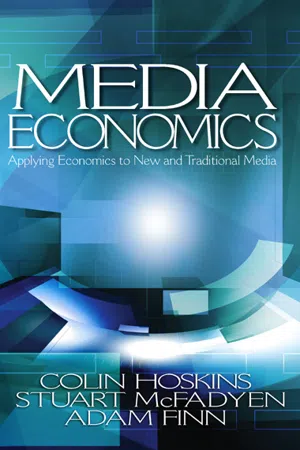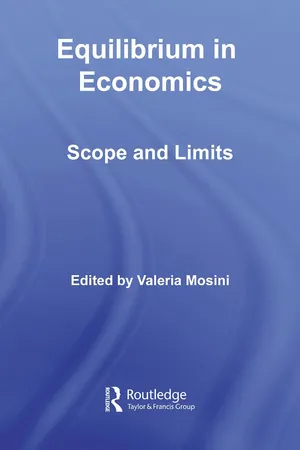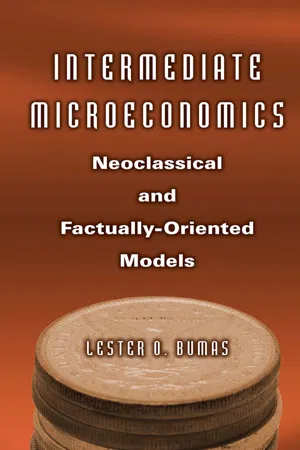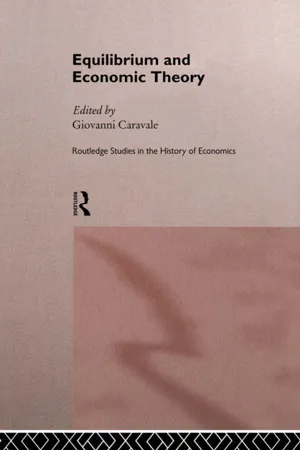Economics
Changes in Equilibrium
Changes in equilibrium occur when there is a shift in the supply or demand curve, leading to a new equilibrium price and quantity. This can be caused by factors such as changes in consumer preferences, input prices, or government policies. When the equilibrium changes, it reflects the new balance between supply and demand in the market.
Written by Perlego with AI-assistance
Related key terms
9 Key excerpts on "Changes in Equilibrium"
- eBook - ePub
- Donald Rutherford(Author)
- 2007(Publication Date)
- Routledge(Publisher)
If seeking an equilibrium is regarded as important then the route to that goal has to be explained. There is an initial choice between price adjustments and quantity adjustments. Prices can be moved up and down until the equilibrium price which will clear the market is achieved. Quantities can be altered by changes in the rate of production and in the use of accumulated stocks until there is neither excess demand nor excess supply. Reaching an equilibrium is not always achievable, as the cobweb theorem shows. Some markets remain in disequilibrium for a long time because of price rigidities. Much of the notion of equilibrium is associated with markets but there can be an equilibrium idea employed in central economic planning where the planners deliberately attempt a series of material balances. The stages of reaching or passing an equilibrium are akin to the phases of an economic cycle. A shock can set a market or economy on a disequilibrium path until forces, including income changes, bring it back to equilibrium.An equilibrium is a desired state of affairs, so that without economic agents revealing their preferences and desires a judgement cannot be made. What might appear to be disequilibrium because of the presence of unsold stocks can reflect the desire of the supplier to have temporary or permanent excess capacity so that there is a higher chance of being able to satisfy customers at any time.In game theory, a strategic equilibrium can take a multitude of forms. In the case of the Nash equilibrium, central to game theory, two or more players in a game cannot benefit by changing their strategies. A Bayesian equilibrium, recognising there is incomplete information, is the consequence of a game in which the players consider expected utilities based on private information concerning the characteristics of the players. A sunspot equilibrium is an allocation of resources dependent on an extrinsic random economic variable.As an equilibrium is a balance between different forces or entities, the term can be applied broadly to cases of a general or market equilibrium. Writers as early as the mercantilists were concerned with the balance between nations, their relative strength, especially as measured by their balances of trade or payments. An internal balance of a country is distinguishable from its external balance with the rest of the world. The internal, according to Meade, has to take into account employment, inflation and wages; the external considers the balance of payments and related international variables such as foreign exchange rates - eBook - ePub
Microeconomics
A Global Text
- Judy Whitehead(Author)
- 2014(Publication Date)
- Routledge(Publisher)
8.3.1 Static vs. dynamic stability of equilibriumIt cannot be taken for granted that a market will always regain equilibrium once its equilibrium has been disturbed. At issue is whether a system, once it moves into disequilibrium, will naturally return to equilibrium. Not all equilibrium positions are stable such that, with any movement away from equilibrium, market forces would naturally be put in motion to induce a return to equilibrium. Thus, it can be said that an equilibrium is stable where, following a disturbance, there is a movement towards a return to equilibrium and unstable if there is not.In summary, the following definitions may be used:- Stable equilibrium – An equilibrium is stable if the conditions are such that there is a return to equilibrium following a disturbance of equilibrium or where the system has been in disequilibrium.
- Unstable equilibrium – An equilibrium is unstable if the conditions are such that the system does not return to equilibrium following a disturbance from equilibrium or where the system has been in disequilibrium.
The stability of equilibrium in a market may be examined from both static and dynamic perspectives. In static stability, only the direction of change is considered, whereas in dynamic stability, the time path of the adjustment is taken into account. This section is concerned only with static stability.Since static stability does not take into account the time path of the adjustment process, it is understood to consider only the nature of the change, that is, whether it is towards or away from equilibrium. It is based on assumptions of market behaviour of buyers and sellers. The exercise being undertaken here is to identify the conditions required for there to be static stability in an isolated market.For there to be static stability of equilibrium in an isolated market, two different conditions must be satisfied. These are identified as: - eBook - ePub
- Rob Dransfield(Author)
- 2013(Publication Date)
- Routledge(Publisher)
An increase in the number of producers will usually increase the supply of a product. Where suppliers leave the market this can reduce the supply. In recent years we have seen a rapid increase in the number of Internet-based suppliers of many goods and services.Effects of changes in supply on the market An increase in supply results in a fall in the price of a product. This leads to a movement along the demand curve (more is bought in response to the lower price). A decrease in supply results in a rise in the price of a product. This leads to a movement along the demand curve (less is bought in response to the higher price). Equilibrium price As an example of how an equilibrium price is reached, a market stall holder at Cambridge market provides bargain umbrellas which he sells to customers – particularly in wet weather. Key TermEquilibrium – a state of balance. An equilibrium price occurs when there is a balance between demand and supply: the quantity demanded by consumers is equal to the amount that suppliers are willing to provide.Competition is fairly intense for other suppliers such as TK Maxx and local garages. The higher the price the market trader can get the more inclined he is to supply more. The lower the price that the stallholder charges, the more customers will buy from him.These demand and supply curves can be illustrated on a single drawing (see Figure 3.8 ).Table 3.7 The demand and supply schedules for umbrellas from the stallholderPrice of umbrellas (£) Stallholder’s supply per month Demand per month 2.50 500 200 2.00 400 400 1.50 300 600 1.00 200 800 Figure 3.8 How the price of umbrellas is determinedYou can now see that, at a price of £2.00 per umbrella, 400 would be bought each month. At this price customers would be happy to buy all 400 and the stallholder would be happy to supply this quantity.This is the equilibrium price, as both seller and buyer are happy with the price.You can see why this point is an equilibrium one by considering non-equilibrium points. For example, at £2.50 the market trader would be prepared to supply 500 umbrellas, but buyers would only be prepared to purchase 200 (leaving 300 unsold). Alternatively, if we examine a price below the market one (£1.00) customers would be willing to buy 800 umbrellas, but the trader would be prepared to bring only 200 to sell. Customers would soon bid the price back up to the equilibrium price. - eBook - ePub
Media Economics
Applying Economics to New and Traditional Media
- Colin Hoskins, Stuart M. McFadyen, Adam Finn(Authors)
- 2004(Publication Date)
- SAGE Publications, Inc(Publisher)
chapter 14 .3.4 Change in SupplyA change in the value of one of the determinants of supply other than own price causes a change in supply . Economists use this term to avoid confusion with change in quantity supplied , which is caused by a change in the price of the product itself. If there is a change in supply, this causes a shift of the entire supply curve. If there is an increase in supply, the supply curve will shift to the right, as more will be supplied than before at any given price. If there is a decrease in supply, the supply curve will shift to the left, indicating that less will be supplied at any given price.3.5 Effect of Change in Supply on Price and QuantityA change in supply causes the equilibrium price to change in the opposite direction to the change in supply. In contrast, the equilibrium quantity changes in the same direction as the change in supply. Figure 3.4 illustrates an increase in supply from S0 to S1 , resulting in a decrease in equilibrium price from P0 to P1 and an increase in equilibrium quantity from Q0 to Q1 . Figure 3.5 shows a decrease in supply from S2 to S3 , causing the equilibrium price to increase from P2 to P3 and the equilibrium quantity to decrease from Q2 to Q3 .Figure 3.4 An Increase in SupplyNote: D indicates demand curve; P, price; Q, quantity; S, supply curve.Figure 3.5 A Decrease in SupplyNote: D indicates demand curve; P, price; Q, quantity; S, supply curve.3.6 Causes of a Change in SupplyA change in supply is caused by a change in the value of any determinant other than own price. Key determinants are the prices of inputs , the state of technology , and the number of suppliers .3.6.1 Prices of InputsInput prices directly affect the cost of producing the industry output. A decrease in input price makes it less expensive to produce output, and firms will be willing to supply more at any given product price. Hence a decrease in input price will increase supply and shift the supply curve to the right, as in Figure 3.4 . Similarly, an increase in input price will decrease supply and shift the supply curve to the left, as in Figure 3.5 - eBook - ePub
- Valeria Mosini(Author)
- 2008(Publication Date)
- Routledge(Publisher)
A central idea in neoclassical microeconomics is that individuals optimise some objective, subject to constraints. The consumer maximises her/his utility subject to income, the producer his/her profits subject to technology, the stock of capital, and expected prices and wages. These optimum positions are often spoken of as equilibria, for, short of that situation, the agents will act to change their consumption or production behaviour. The absence of change was for a long time one hallmark of the economists’ concept of equilibrium (though this was later altered, as we shall see). This optimising concept has the implication that in equilibrium all unexploited opportunities have been exhausted. When generalised to ‘markets’ which involve the interaction of many agents, we have the concept about which Hicks was quite passionate: ‘There is an equilibrium when all individuals are choosing the quantities, to produce and consume, which they prefer. To a conception of equilibrium that is of this type we must hold fast’ (Hicks 1965, p. 23). Agents are not only choosing what they prefer, but can actually realise their choices. Thus this concept of equilibrium carries with it the implication of co-ordination of plans.Market clearing
Utility maximising lies behind the construction of demand curves, and profit maximisation behind supply curves. It is thus an easy step to move to equality of supply and demand, or market clearing, as the criterion of equilibrium at a market, rather than individual, level. Although it comes to the same thing as Hicks’s criterion, it connects with an earlier tradition, which derived from the original meaning of equilibrium: a balance of forces (from aequus, equal, and libra, balance). The actions taken by consumers and producers to achieve their optimum positions constitute the ‘forces’.A position of rest
In nineteenth and early twentieth century economics the use of the term ‘equilibrium’ is often non-technical and descriptive: for example, equality of (the value of) exports and imports is balance-of-payments equilibrium (the capital account was not dominant as now). When a balance of these forces was achieved, there would be no further endogenous movement until the balance was disturbed by some exogenous change. Thus equilibrium became quite generally understood as a position of rest. This position can be brought about either by a single force acting within the context of a constraint or a limit (as in the choice-theoretic concept) or (more usually in economics) by a balance of forces. Thus this concept has a dynamic story behind it, of which it is a culminating point. Famously, Marshall borrowed both biological analogies and the metaphors of the pendulum and the rest position of balls in a bowl to illustrate the concept: - eBook - ePub
- Andrew Barkley, Paul W. Barkley(Authors)
- 2020(Publication Date)
- Routledge(Publisher)
Chapter 16 . In all other businesses and professions, the tools related to supply and demand are useful in determining how market forces will affect the price and quantity of inputs and outputs.10.3 Comparative statics
The study of markets provides managers of business firms with a powerful method of understanding and analyzing how prices of the firm’s inputs and outputs change over time. This knowledge can lead to improved decision-making and higher levels of profit for the firm. The interaction of supply and demand results in an equilibrium market price and quantity. The study of the impacts of changes in supply and demand relationships is called comparative statics , a method of comparing one equilibrium point with another.- • Comparative Statics = a comparison of market equilibrium points before and after a change in an economic variable.
The study begins with the impacts of changes in demand, then moves to changes in supply, and, finally, to simultaneous changes in both supply and demand. Careful consideration of these comparative static examples provides useful insight into analyzing any economic policy, change, or situation.10.3.1 Changes in demand
The large and enduring increases in China’s per-capita income are likely to continue to have a positive impact on the demand for beef and grain produced in the United States. Consumers with increasing income levels tend to substitute out of inexpensive calorie sources, such as grains, and into more expensive sources, such as beef and seafood. Figure 10.3 shows this increase in demand for beef.Figure 10.3 An increase in the demand for beefThe outward shift in the demand curve (from Qd 0 to Qd 1 ) is a change in demand (not a change in quantity demanded), since the source of the change is a nonprice variable (the increase in per-capita income in China). The equilibrium point in Figure 10.3 changes from E0 to E1 because of the change in demand. As the demand curve shifts upward and to the right, it sweeps across the supply curve from one equilibrium point to another. The change increases the price of beef from P*0 to P*1 , causing a change in quantity supplied, or a movement along the supply curve, as shown in Figure 10.3 - eBook - ePub
Intermediate Microeconomics: Neoclassical and Factually-oriented Models
Neoclassical and Factually-oriented Models
- Lester O. Bumas(Author)
- 2015(Publication Date)
- Routledge(Publisher)
Y . The market for blue-chip stocks and bonds, however, is virtually worldwide. They are sold in many countries. Moreover, were they any cheaper in Tokyo, London, or Frankfurt, than in New York, there would be a tendency to buy the stocks at the cheaper stock exchange. The implied increase in demand at the lower-priced market drives price up; as the decreased demand at the higher-priced market drives price down. Thus, the tendency is toward one price.Equilibrium and Its Attainment
Our concern here is with how the market equilibrates the supply and demand price and the quantity demanded and supplied. There are two approaches to the attainment of equilibrium. One is that of Leon Walras; the other the creation of Alfred Marshall. Textbooks generally utilize a simplified version of Walras’s model, which is presented first. Marshall’s takes second place. The examples used by both Walras and Marshall involved commodities exchanged in auction markets.Walras’s Model
In Figure 3.1 can be found hypothetical market supply and demand functions. The product in question is wheat. The demand function is shown as negative-sloped, a manifestation of the income and substitution effects. The supply function is shown as positive-sloped in keeping with the law of diminishing marginal returns or marginal productivity.Figure 3.1. Equilibrium via the Response of Price to Quantity DisequilibriaAssume, that at the start of the trading day the price of wheat isPHI. At that price the quantity supplied exceeds the quantity demanded yielding the surplus shown. That surplus causes the price to be bid down until the quantity supplied equals that demanded. At that quantity equilibrium, the market-clearing or equilibrium price,PEQ, would occur.Equilibrium - eBook - ePub
- Giovanni Alfredo Caravale(Author)
- 2002(Publication Date)
- Routledge(Publisher)
However, Marshall’s reflection on this methodological knot does not go beyond recognizing that this fact ‘is the source of many of the difficulties that are met with in applying economic doctrines to practical problems’ (ibid.), and his theoretical construction remains firmly anchored to the conception that ‘the nature of equilibrium itself, and that of the causes by which it is determined, depend on the length of the period over which the market is taken to extend’ (1966: 274). On this ground, the analysis Marshall conducts of the various possible cases that can be identified in correspondence with possible supply conditions obviously leaves unanswered the incisive methodological question he himself had raised.It is worth while stressing again that the logical conception of the long-period position suggested here appears capable of solving the problem of the continuous change in the ‘general conditions of life’ without doing away with the possibility of a meaningful reference to the equilibrium position. This position, in fact, remains the fundamental concept for interpretations of the economic system – even in the awareness that this latter will, presumably, never succeed in actually reaching the equilibrium position, continuously changing through calendar time3. The line of argument developed above deals with changes that have an exogenous nature with respect to the model, i.e. variations in economically significant parameters or data on the basis of which the equilibrium position, that represents the initial reference point of the analysis, is defined. It is worth stressing that, in the approach suggested here, new values concur to define a new equilibrium position for the system, hence a new potential centre of attraction.These variations can derive either from events that are not of a strictly economic nature (for example, population changes stemming from new ethical, religious or social values, changes in the state of expectations linked with political change) or from economic events which are not taken into consideration in the functional relations that make up the theoretical model. An example of an event of the latter type could be offered, in an income determination model, by the exogenous - eBook - ePub
Markets for Managers
A Managerial Economics Primer
- Anthony J. Evans(Author)
- 2014(Publication Date)
- Wiley(Publisher)
Comparative statics can be as complicated as you wish to make it. And in the real world multiple shocks will take place simultaneously, which means there's a limit to how much we can observe these effects. But it's precisely because the real world is complex, that we need a clear theoretical lens. If planning restrictions are lifted at the same time as population rises, the positive shift in the demand curve (upward pressure on prices) will coincide with a positive shift in the supply curve (downward pressure on prices). In the real world we can't hold all other variables constant, so the predictive power is severely curtailed. But there is use in knowing that a rise in population will mean that prices are higher than they otherwise would be. And indeed since both shocks imply an increase in quantity, comparative statics can still help us form a vision of the future.The key reason why the market ‘finds’ a new equilibrium following a shock is because the price system adjusts to the new economic reality. Provided the price can reflect the underlying demand and supply curves, we expect to reach equilibrium, for the gains from trade to be fully exploited and for markets to ‘clear’. It's the price system that does the remarkable job of converting our subjective value into terms that can be compared with other people. There is a certain beauty in the way this occurs, and Alexis Kirke and Greg Davies actually used the noise of an open outcry trading floor as the basis for an opera.5 As George Shackle elucidated, prices allow our subjective values to find a type of social harmony:Though valuation is in origin the personal and private act of the individual mind, yet it becomes through the device of the market a public and objective fact upon which every individual, at least in regard to goods for immediate consumption, agrees … Prices, given this public authority and validity, enable collections of the most diverse objects to be measured in a single dimension … economics might almost be defined as the act of reducing incommensurables to common terms.6As you might expect, if prices are prevented from functioning in this way markets will be less able to bridge buyers and sellers. Therefore price controls (laws that ‘set’ prices at certain levels) will be highly disruptive. There are two types of price control – ones that set prices above their equilibrium/market-clearing rate, and those that set prices below it. When prices are kept below their market-clearing rate, we call it a price ‘ceiling’. This is because policymakers are trying to prevent it from rising upwards towards equilibrium. If prices are kept above
Learn about this page
Index pages curate the most relevant extracts from our library of academic textbooks. They’ve been created using an in-house natural language model (NLM), each adding context and meaning to key research topics.








